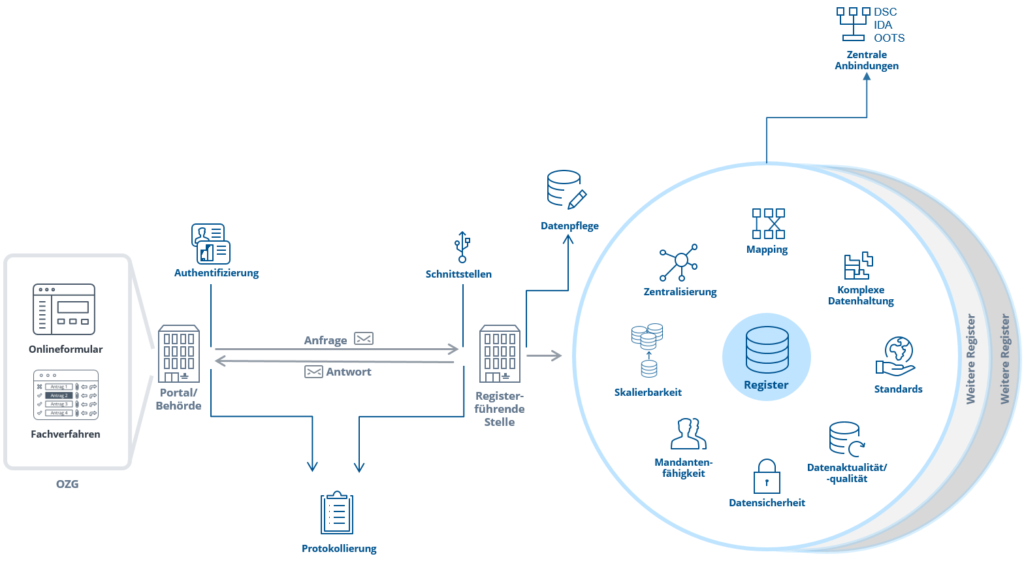Modern, digitized registers are an essential basis for a networked bureaucracy. They should enable citizens and companies to submit applications without having to submit evidence more than once. The Register Modernization Act at national level and the Single Digital Gateway Regulation (SDG Regulation) at international level serve as legal requirements for this. But what sounds so simple brings with it many challenges due to the complex register landscape characterized by federal structures.
Short & concise
- The implementation of modern registries requires a fully comprehensive analysis in all areas.
- In order to connect a registry to the components of the IT Planning Council architecture in accordance with national and international requirements, it is necessary to use standards and existing structures.
- The use of a low code platform offers the possibility to solve business and technical challenges in a time- and cost-saving way.
While work is still underway to implement the service bundles defined in the Online Access Act (OZG), the next major project is already underway to digitize a fundamental part of the structures of the public sector: Register modernization. While the OZG obliges the federal and state governments to offer administrative services electronically, the associated processes are often characterized by media discontinuities. This is now where the Register Modernization Act (RegMoG) comes in.
All relevant registers should be able to communicate with each other, taking data protection into account. The hoped-for gain is the provision of necessary data for applications and specialized procedures without media discontinuity and more convenient data maintenance for the specialized user. Based on the overarching, semantic, technical, organizational and legal guiding principles defined by the IT Planning Council, the task for each registry is to understand the processes, analyze them and convert them into a rule-compliant, modern implementation that makes optimal use of existing standards and structures.
Process analysis as the basis for the register strategy
If the opportunity arises to modernize a register in the course of the legal requirements, the chance should be taken to analyze the entire data lifecycle. The identification of digitization potentials and possible effects on specialized processes are the resulting outcomes.
Is data management centralized or decentralized? Is there a superordinate instance to which reporting must be made? Is there the possibility to design processes more efficiently and thus to use and manage the data more efficiently? How high is the updating requirement of the data? Are the responsibilities defined in the specialist process? Do adjustments need to be made in the specialized law? What evidence is required for the specialist process? This is only a small part of the relevant questions to better understand the existing structures and, based on this, to start a possibly necessary process transformation.
A long-term program such as register modernization entails many factors that already play an important role when the strategy for digitization is being drawn up. Legal requirements stipulate the use of certain components, checks or standards. In addition, it is also necessary to work out the organizational differences of the respective register-keeping bodies. The IT strategy for these agencies is supplemented with individual goals based on the guiding principles and transferred to a separate register program. By recording the overall situation, the fields of action are identified, prioritized and put into planning after a focus analysis. Hybrid project management is used to provide success-oriented support for the technical implementation of the sophisticated architecture.
Technical architecture – connection of registers at all levels
The target image of the register modernization envisages not only a linking of the registers nationally, but also internationally. At the national level and across administrative areas, the IT Planning Council has defined an architecture that meets the high data protection requirements by means of the 4-corner model. The following components of the architecture are worth highlighting here:
- The IDA procedure (identity data retrieval procedure) is used on the one hand to retrieve the identification number and on the other hand to compare the basic data of an individual person in the existing database.
- With the data protection cockpit, citizens can view the data flows required for their OZG service and their personal data.
- The register data navigation serves as a central routing service and provides retrieving agencies with the information from which specific authority they can retrieve necessary evidence and which technical parameters are required for this.
- In order to identify a requesting citizen, a company or an authority and to check whether they are authorized to retrieve corresponding data, identification and authentication management is of central importance.
- In order to enable a connection to the European Once-Only-Technical-System (OOTS), an SDG-Connector is currently being developed by the overall control Register Modernization.
Fig.: Central starting points and components for the digitization of a registry in the context of registry modernization. The goal is end-to-end digitization from the application, based on the OZG, to the database of a registry, taking into account all components to be integrated. Depending on the complexity of a specialized procedure, data retrieval is performed from a varying number of registers.
At this superordinate level, the targets for the digitization of registers are clearly specified. In individual cases, however, a number of special features must be taken into account. For example, decentralized registers can first bundle their data and log retrievals. This is done, for example, via head registers at the state or federal level. If mirror registers come into play, these must also find their place in the overall architecture.
One variant for modernizing decentralized registers is to use a cloud designed for this purpose. In this, the register software is “packaged” in containers and can then be rolled out individually for each client. At the same time, management is centralized, which means that supporting dozens of instances does not cause more work than supporting a few. Together with the other advantages of a cloud, such as fail-safety and high scalability, this approach offers the opportunity to realize the increasingly complex requirements of the future while reducing costs.
Relevance of standards in the digitization of databases
When it comes to the core of the register, the data management, a very heterogeneous level of digitization can currently be found here as well. On the one hand, there are registers such as the Hamburg Ship Register that are fully digitized, while on the other hand, in some registers, such as the civil status registers, the majority of entries are still on paper.
If a register needs to be upgraded, care should be taken to incorporate standardized interfaces right at the implementation stage. If the level of digitization is advanced, a decision must be made on a case-by-case basis: Will the interfaces be adapted or newly implemented? Or does mapping translate the existing, non-standardized interfaces into a connectable data structure? Regardless of the level of digitization, however, a certain mapping effort must always be made. Experience from applications that are already running, such as ELSTER, can contribute to more robust, long-lasting data processing in this regard.
In addition to the use of standardized interfaces, the use of XÖV standards for data transfer also contributes significantly to the standardization of data transfer and processing. Existing XÖV standards can be viewed in the XRepository and new standards, if necessary, can be developed from the projects in cooperation with KoSIT (Coordination Office for IT Standards).
Another challenge with some of the registers lies in the complex data management. In some cases, for example, data may never be deleted in order to be able to clearly define ownership claims. However, experience from the digitization of the Hamburg Ship Register shows that appropriately secure storage of corresponding data on a relational database is possible via a document-driven approach in the form of log entries. Locking the application during the signature process additionally increases the security of data storage. This approach can be transferred to a large number of registers with complex data storage.
Registers & their maintenance – the specialized procedure
In addition to technology, professionalism also plays a major role in register modernization. When a register is digitized for the first time, a related specialized procedure for data maintenance is provided and organizational responsibilities are assigned. In the case of registers that have already been digitized, an existing specialized procedure must be reviewed and expanded in the context of register modernization. In both cases, major implementation efforts are required. A time- and cost-saving alternative to pure individual development is the model-based development of specialized procedures using low code platforms. These offer experts the opportunity to map complex validations and interrelationships – i.e., the technical aspects – themselves.
For example, legally relevant processes such as the redaction or signing of amended register entries by judicial officers can be quickly digitized using low code. The improvement in data quality and up-to-dateness called for by the IT Planning Council in connection with register modernization, which must be checked by the business user, can also be achieved directly in the business process through supporting technical processes. Ultimately, the interaction between business and technical processes is the key to the successful digitization of a registry.
More on the subject of register modernization also at the Digital State in Berlin:
Draining the data swamp – Pulling up modern and networked registers
Expert Forum 18: Wednesday, April 26, 1:30-15:00 p.m.
Moderation: Christoph Harnoth, National SDG Coordinator at the Federal Ministry of the Interior and Home Affairs (BMI)
Impulse: Dr. Brigitte Klamroth, Office for IT and Digitalization Senate of the Free and Hanseatic City of Hamburg
Janos Standt, Division Manager Public Sector, mgm
Simon Sebastian Hunt, Competence Center Public IT (ÖFIT)
Stefan Rauner, General Portfolio Manager/Prokurist, Governikus
Faruk Tuncer, CEO and Founder, Polyteia
Further information:
- Register Modernization Act: https://www.gesetze-im-internet.de/regmog/BJNR059100021.html (german only)
- SDG Regulation: https://eur-lex.europa.eu/legal-content/DE/TXT/PDF/?uri=CELEX:32018R1724 (german only)
- FITKO – KoSIT: https://www.it-planungsrat.de/fileadmin/beschluesse/2023/Beschluss2023-08_Rahmenvereinbarung_AL4_2023.pdf (german only)








